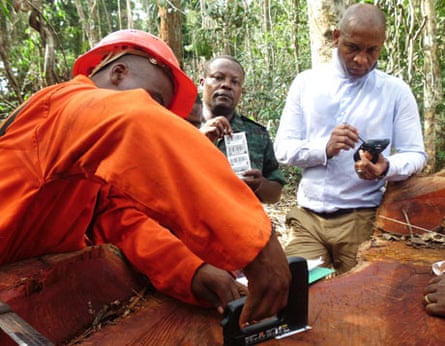The prized tropical hardwood merbau was once found in abundance from east Africa to Tahiti. It is beloved of homebuilders and furniture stores around the Asia-Pacific region, but, thanks to decades of merciless logging, today only New Guinea holds enough to be harvested in commercial quantities.
Verifying that merbau, which fetches about $2,500 a cubic metre on the open market, is genuinely sourced from sustainably forested areas, either in Papua New Guinea or West Papua in Indonesia, gives the conscientious buyer an almighty headache. But it is also proving a boon for wily technology companies.
Tracking timber
In 2007, Simmonds Lumber, a wholesaler based in Sydney, became the first company in the world to trial a new technology involving DNA sampling and testing. Developed by DoubleHelix, based in Singapore, and certification body Certisource, the technology involves checking wood fibres against the genetic code of trees known to exist in sustainably managed areas.
As a business that imports more than 50 containers a month of merbau into the country, mainly from Indonesia, it was essential to ensure that the wood was coming from where its suppliers claimed, explains John Simon, chief executive at Simmonds Lumber. "The trickiest thing about importing from Indonesia is ensuring that the paperwork is correct and not, as we say in Australia, bodged up."
And, at least according to Simon, the Double Helix DNA tracking system provides a higher standard of proof than that offered by either the Forest Stewardship Council or the Programme for the Endorsement of Forest Certification, both of which he says focus on auditing company processes, not authenticating individual shipments.
However, DNA testing is not the only tracking technology being employed by suppliers and customers keen to ensure that they are not felled by fraud perpetrated by sawmills, factories or traders. Companies such as Track Record and SGS have popped up in recent years to offer software, digital barcoding, radio frequency identification tags and even satellite tracking to corroborate timber batches.

"Technology can play a real part in proving traceability," insists Karim Peer, chief executive of Helveta, a firm based in Oxford, which offers a "digital passport" for buyers and sellers. Helveta's verification system, used in countries such as Liberia and the Democratic Republic of Congo, claims to track a product back to the forest where it began life as a sapling using barcode tags, which are then fixed to the product.
The introduction of tough new legislation aimed at combatting the trade in illegally sourced timber – such as the 2008 amendments to the US Lacey Act, 2012 Illegal Logging Prohibition Act in Australia, and 2010 EU Timber Regulation – has helped increase the appeal of authentication technologies, Peer says.
"The impetus for organisations in Europe and the US is that under the legislation, there are penalties that will be imposed if they don't comply," explains Peer. These penalties include criminal convictions, fines and even prison sentences – a sobering thought for a wholesaler or retailer who might have otherwise drawn comfort from their wilful ignorance of the supply chain.
Tackling the fraudsters
While new technologies may offer promise, neither the Forest Stewardship Council (FSC) nor PEFC currently mandate that their members adopt them. According to Jonathan Geach, executive director of Double Helix, this leaves their chain-of-custody systems open to abuse, which he says act more like an "honour system" based on trust.
The access to markets and suppliers that FSC or PEFC certification offers creates a "perverse incentive" for fraudsters to cheat the system, adds Geach.
"FSC is very good at making sure that forests are well run, but, once a product gets out of a forest, you have myriad middle men and traders," Geach says.
"Factories that sell certified products also sell uncertified products alongside. Now it doesn't take much imagination to see that they may be mixing and through that laundering."
However, to accuse the FSC or PEFC of being blind to the opportunities presented by technology would be unfair. Phil Guillery, systems integrity director for FSC International, explains that his organisation is already embarking on a project with Historic Futures, another British IT firm, to develop an online claims platform to verify the certification status of FSC suppliers.
"As the FSC has grown to cover almost every product from maple syrup to wood furniture – from the B&Qs and Ikeas of this world to small operations – [we have found that] the paper-based system we created needs to be modernised," Guillery says.
DNA technology is under consideration, Guillery acknowledges, but he expresses reservations about its limitations.
"At this point, the cost effectiveness and the science aren't quite there," he says. "You can't do testing on paper or lots of composite wood products because the DNA is generally removed. For some tropical species, there are many closely related relatives, which also makes it difficult."
For all this focus on technology, there is a danger that companies may not see the wood for the trees, so to speak, at least when it comes to other important issues related to sustainable forest management.
"I don't see how a DNA test will guarantee that workers in Malaysia or China or anywhere have their freedom of association or bargain rights honoured. I don't see how barcoding will guarantee that forest workers come home at night with the body parts that they left with in the morning," says Bill Street, chairman of PEFC's board of directors.
"The goal, at least for PEFC, is that we put an end to deforestation and that requires focusing on a much larger picture than just technology."
This content is brought to you by Guardian Professional. Become GSB member to get more stories like this direct to your inbox.

Comments (…)
Sign in or create your Guardian account to join the discussion